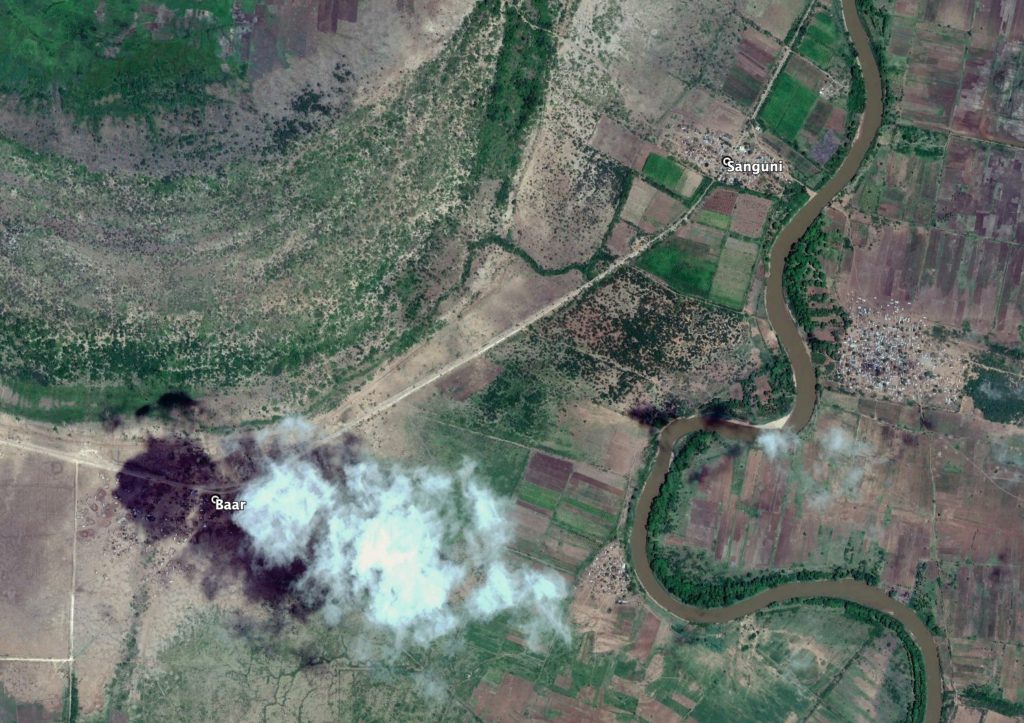Incident Code
Incident Date
Location
Geolocation
Geolocation
Airwars Assessment
(Previous Incident Code: SOM100)
An American Special Forces soldier was killed – later named as Staff Sergeant Alexander Conrad – and four others were wounded in an attack by al Shabaab fighters in Jubaland. A member of a partner force was also killed or injured.
The US soldiers were among a large force of 800 Somali and Kenyan soldiers conducting a “multiday operation”, US Africa Command said. The mission’s objective was to “clear al Shabaab from contested areas, liberate villages from al Shabaab control, and establish a permanent combat outpost,“ according to a press release from the command, with US forces providing “advice, assistance and aerial surveillance”.
The group however came under attack from mortar and small-arms fire at around 2:45pm (local time). US Department of Defence officials said they were at a small outpost near the town of Jamaame when the incident occurred. The US team was backed up by armed surveillance aircraft overhead, but the location of the mortar fire could not be determined in what one official called “a very quick engagement” by the militants, according to the New York Times.
The official statement from US Africa Command read: “A large force consisting of approximately 800 forces from the SNSF and KDF were conducting a multi-day operation approximately 350 kilometers southwest of Mogadishu when the attack occurred. The mission’s objectives were to clear al-Shabaab from contested areas, liberate villages from al-Shabaab control, and establish a permanent combat outpost designed to increase the span of Federal Government of Somalia (FGS) security and governance. The U.S. provided advice, assistance and aerial surveillance during the mission.”
The FGS is dedicated to restoring peace and stability to the Somali people, and the U.S. supports those efforts. This mission was specifically designed to increase the FGS’s ability to provide vital government services to innocent civilians living under al-Shabaab’s rule. The population in the region had historically supported the government, and the Somali forces had prepared for this mission by coordinating heavily with and securing the support of local authorities ahead of time.”
According to the Daily Beast, al Shabaab had put significant planning into the attack: “According to civilians in the area around Sanguni reached by telephone, two weeks before the attack on Friday in which Staff Sgt. Conrad was killed, Al Shabaab militants had taken a number of measures to protect their terrain: they told civilians living in the area to leave, they shed their military uniforms for civilian clothing, they brought in reinforcements from surrounding villages, and they dug out the banks of the Jubba River at a village called Jii-way, dumping the dug-up earth into the shallow riverbed itself to create a pseudo-dam.
As a result, water from the river began flooding the surrounding area making it nearly impassable: farms of mango and banana trees became wetlands and fruit and vegetable prices increased five fold in the nearby city of Kismayo as the remaining farmers left their land. “They completely destroyed the nearby farms, the water reached as far as two or three kilometers from the river,” said one local leader who preferred to remain anonymous for security reasons.
With the area now a marshland – a literal quagmire – the joint force was compelled to seek higher ground to build their COP in an area two kilometers away from the central village of Sanguni. The exact spot is called “Baar” or “Baarka Sanguni”: once home to a bar run by the Italians who colonized the area and managed the farms along the Jubba River. It’s situated on a hill under the shade of mango and banana trees, and in colonial times a semicircular wall enclosed a garden where Italians and well-to-do Somalis clinked wine glasses and enjoyed a light breeze coming off the river. By the time the joint force arrived with their trucks and excavators, physical remnants of that history were long gone.
Locals in the nearby village, Jeneraal Jay, who had fled their farms when they flooded, told The Daily Beast that on Thursday morning there was a firefight between Al Shabaab militants in the area and the allied forces in Baarka Sanguni. They said one civilian, a teenage girl, was killed in the crossfire. After the exchange, some families fled to the nearby town, Jamaame.”
While most reports said one partner force member was injured in the attack, the Wall Street Journal said a Somali trooper was killed, with VOA putting the death toll of local forces at two.
Key Information
Geolocation Notes
Reports of the incident mention an outpost in Baar or Baarka Sanguni, 2 kilometers away from the central village Sanguni, near the town Jamaame. The coordinates for Baar are: -0.007114, 42.640372. Due to limited information and satellite imagery available to Airwars, we weren’t able to verify the location further.

The village Baar, 2 kilometers away from Sanguni
Imagery: Google Earth
